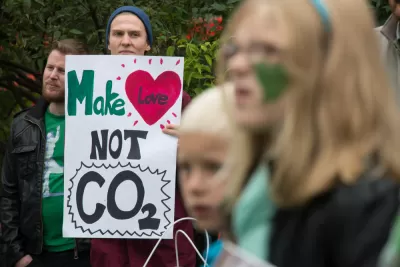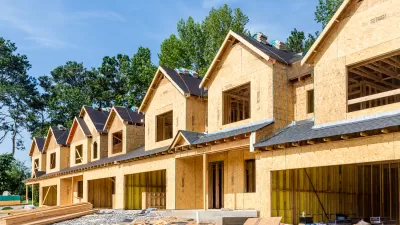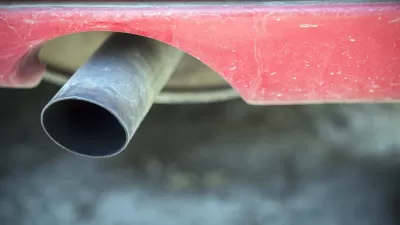As difficult as it was for the legislature to pass SB 32 on Aug. 24, reducing emissions 40 percent below 1990 levels by 2030 will prove far more challenging. Brad Plumer, senior editor of Vox, explains the bill and what it will take to meet the goal.

California ranks at the top of states fighting climate change, in large part because of laws, executive orders, and regulations passed by the state's largely Democratic legislature, progressive governors, including Republican Arnold Schwarzenegger, and forward-thinking regulatory agencies.

In a comprehensive article, Plumer spells out what lies ahead for the Golden State now that it passed one of the most far-reaching climate change mitigation bills in the country. He also describes many of the existing laws and regulations, many of which are implemented by California Air Resources Board, an agency that has grown in power and is viewed with some controversy.
It’s hard to overstate how ambitious this is. Few countries have ever achieved cuts this sharp while enjoying robust economic growth. (Two exceptions were France and Sweden in the 1980s and ’90s, when they scaled up nuclear power.) The EU is also aiming for a similar 40 percent cut below 1990 levels by 2030, though they’ve got a head start. [They've also got much higher gas and diesel prices dues to taxation].
Policymakers everywhere will be watching to see if California can pull this off. Getting a 40 percent cut will require more than bucking up wind and solar and putting more electric cars on the road. It will mean reshaping virtually every facet of the state’s economy, from buildings to transportation to farming and beyond.
Why the 40 percent reduction by 2030 goal will be difficult to meet
In fact, "difficult" is more than an understatement. "Herculean" is what Jim Sweeney, director of the Precourt Energy Efficiency Center at Stanford University told Paul Rogers, natural resources and environmental issues reporter for The Mercury News [more below from Rogers].
Speaking of nuclear power, which were key to earlier efforts by France and Sweden to reduce carbon emissions, Plumer notes that the state's largest source of carbon-free power, the only remaining nuclear power plant in California, will close in 2025.
- While Gov. Jerry Brown and most Democrats were able to overcome strong lobbying by Big Oil, that wasn't the case last year with a critical climate bill, SB 350, that had the oil reduction provision stripped. With almost 40 percent of the state's greenhouse gas emissions coming from transportation, it will be difficult to cut emissions without cutting oil consumption. David Roberts, Plumer's colleague, wrote extensively last year on how the oil industry continues to hamper legislative efforts to cut emissions.
- The nation's only state-run cap-and-trade program, which sell carbon allowances to emitters, faces a 'cloudy future' with plummeting revenues, notwithstanding the assertion by Sen. Fran Pavley, author of SB 32, that passage of the bill would "stabilize the cap-and-trade auction market." Plumer devotes a section toward the end of the article exclusively to the 'hazy' future of cap-and-trade.
While the challenges are formidable, the 'bottom line' is that "SB 32 was a huge, huge deal," observes Plumer.
Climate hawks won a major victory over industry groups who fought the bill tooth and nail. California will extend its landmark climate efforts into 2030. Drastic emissions cuts are now written into law.
Existing climate laws and regulations
Beginning with AB 32 in 2006, and in addition to cap-and-trade, CARB and other agencies administer:
- The low carbon fuel standard that is designed to reduce the carbon intensity of transportation fuel 10 percent by 2020.
- Renewable Portfolio Standard, just increased to 50 percent of electricity generation from renewable sources by 2030 thanks to passage last year of SB 350, which also calls for the next item on the list.
- Doubling energy savings in existing buildings & developing cleaner heating fuels by 2030 [PDF].
- Incentives, like rebates, for zero emission, and near zero emission vehicles, though funding is currently exhausted. With the Aug. 31 agreement by Gov. Brown and Senate President pro Tempore Kevin de León and Assembly Speaker Anthony Rendon, funding $133 million will be allocated to the Clean Vehicle Rebate Program.
- CARB oversees requirements to reduce emissions in transportation, as administered by the state's metropolitan planning organizations under SB 375, the Sustainable Communities and Climate Protection Act of 2008.
What it will take to reduce emissions 40 percent below 1990 levels by 2030
"Anyone can put lofty climate goals on paper," writes Plumer, though getting those goals passed by a legislature and signed by a governor is huge in itself. "The real question is whether California can undertake the specific actions needed to actually cut emissions."
Plumer delves into "a 2015 paper by Jeffery Greenblatt of Lawrence Berkeley National Laboratory, who created a detailed model to see what effect various state actions might have in reducing California’s greenhouse gases."
Greenblatt’s conclusion was that a 40 percent cut below 1990 levels looked doable, but it would take major changes across a wide variety of different sectors, from boosting clean electricity to ratcheting up building efficiency to managing pastures better to reducing car travel to cutting the HFCs in air conditioners.
This is probably, pardon the bad pun, the meat of Plumer's piece. Readers should scroll way down to 'scenario S3' to see what Greenblatt's plan entails. And yes, it includes high-speed-rail.
Paul Rogers, resources and environmental issues reporter for The Mercury News, also writes on what Californians might expect to see if the state is to reduce emissions 40 percent below 1990 levels in 14 years.
Not only will automakers be required to actually sell more zero emission vehicles, that is, if they can fix the broken credit system, there could be "penalties for people who buy gasoline-powered vehicles."
Interestingly, in a transportation funding bill proposed this week by the leaders of the Senate and Assembly Transportation Committees, a $165 annual fee is charged to electric vehicles that pay no gas tax, showing the how environmental and infrastructure goals can collide.
Rogers also cites Greenblatt of Lawrence Berkeley National Laboratory and his work, as does Plumer.
Finally, there's one more important issue to address if the reductions are to be met, and that has to do with the future of the state's environmental movement and the role of the Air Resources Board, but that will be the subject of a forthcoming post.
FULL STORY: California is about to find out what a truly radical climate policy looks like

Pennsylvania Mall Conversion Bill Passes House
If passed, the bill would promote the adaptive reuse of defunct commercial buildings.

Planning for Accessibility: Proximity is More Important than Mobility
Accessibility-based planning minimizes the distance that people must travel to reach desired services and activities. Measured this way, increased density can provide more total benefits than increased speeds.

Fair Housing Cannot Take a Back Seat to ‘Build, Baby, Build’
If we overlook fair housing principles in the plan to build US housing back better, we risk ending up right back where we started.

LA Metro Board Approves New 710 Freeway Plan
The newest plan for the 710 corridor claims it will not displace any residents.

Austin’s Proposed EV Charging Rules Regulate Station Locations, Size
City planners say the new rules would ensure an efficient distribution of charging infrastructure across the city and prevent an overconcentration in residential areas.

Making California State Parks More Climate-Resilient
A recently released report offers recommendations for keeping state parks healthy and robust, including acquiring additional land for conservation and recreation.
City of Costa Mesa
Licking County
Barrett Planning Group LLC
HUD's Office of Policy Development and Research
Mpact Transit + Community
HUD's Office of Policy Development and Research
Tufts University, Department of Urban and Environmental Policy & Planning
City of Universal City TX
ULI Northwest Arkansas
Urban Design for Planners 1: Software Tools
This six-course series explores essential urban design concepts using open source software and equips planners with the tools they need to participate fully in the urban design process.
Planning for Universal Design
Learn the tools for implementing Universal Design in planning regulations.

























